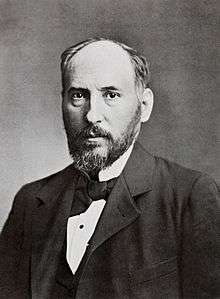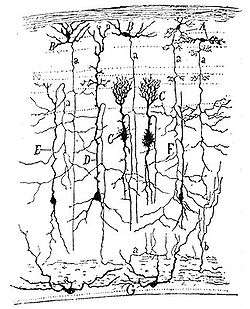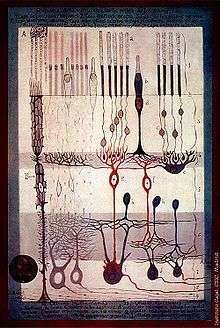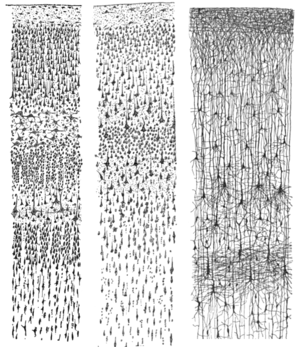Santiago Ramón y Cajal
| Santiago Ramón y Cajal | |
|---|---|
 | |
| Born |
1 May 1852 Petilla de Aragón, Navarre, Spain |
| Died |
17 October 1934 (aged 82) Madrid, Spain |
| Known for | the father of modern neuroscience |
| Signature | |
 | |
Santiago Ramón y Cajal[1] (Spanish: [sanˈtjaɣo raˈmon i kaˈxal]; 1 May 1852 – 17 October 1934)[2] was a Spanish pathologist, histologist, neuroscientist, and Nobel laureate. His original pioneering investigations of the microscopic structure of the brain have led to his being designated by many as the father of modern neuroscience. His medical artistry was legendary, and hundreds of his drawings illustrating the delicate arborizations of brain cells are still in use for educational and training purposes.[3]
Names often misstated
Santiago Ramón y Cajal is often called Cajal despite the fact that Ramón was his paternal surname and his maternal surname was Cajal. Thus, for example, the greatest living neuroscientific expert on Ramón y Cajal, the Spaniard Javier DeFelipe, titled his review of Cajal's scientific work in Nature Reviews Neuroscience "Brain plasticity and mental processes: Cajal again." (Vol 7, issue 10, pp 811-817). Even in Spain (where this naming convention is the norm and it would be expected that he be referred to as "Ramón"), when Ramón y Cajal's work is referred to, there is a preference for his mother's surname, Cajal, perhaps because "Ramón" is also a forename, or simply because Cajal is a less frequent surname, what is common practice for personalities. Thus, many texts say for example, "escuela cajaliana" (Cajal's school) or "Cajal's disciples." It should, however, be noted that some of Cajal's own articles were published under the name "S. R. Cajal", even in his own journal (e.g., Algunas consideraciones sobre la mesoglia de Robertson y Rio-Hortega. Trabajos del Laboratorio de Investigaciones Biológicas de la Universidad de Madrid 18 (1920): 109-127). Further, his European contemporaries generally referred to him as 'Cajal' (see, for example, reviews in Zeitschrift für die gesamte Neurologie und Psychiatrie).
Biography
As a child Ramón y Cajal was transferred many times from one school to another because of behavior that was declared poor, rebellious, and showing an anti-authoritarian attitude. An extreme example of his precociousness and rebelliousness is his imprisonment at the age of eleven for destroying his neighbor's yard gate with a homemade cannon.[4]
He was an avid painter, artist, and gymnast, but his father neither appreciated nor encouraged these abilities, even though these artistic talents would contribute to his success later in life. In order to tame the unruly character of his son, his father apprenticed him to a shoemaker and barber. "To try and give his son much-needed discipline and stability, Don Justo apprenticed him out to a barber".[5] He was well known for his pugnacious attitude as he worked.
Over the summer of 1868, Ramón y Cajal's father, hoping to interest his son in a medical career, took him to graveyards to find human remains for anatomical study. Sketching bones was a turning point for him and subsequently, he did pursue studies in medicine.[6]:207
Ramón y Cajal attended the medical school of the University of Zaragoza, where his father was an anatomy teacher. He graduated in 1873. After a competitive examination, he served as a medical officer in the Spanish Army. He took part in an expedition to Cuba in 1874–75, where he contracted malaria and tuberculosis.[2] In order to cure these conditions, he attended the Panticosa spa-town in the Pyrenees.
After returning to Spain he married Silveria Fañanás García in 1879, with whom he had four daughters and three sons. In 1877, he received his doctorate in medicine in Madrid and was awarded the position of anatomy professor of the University of Valencia in 1883. He later held professorships in both Barcelona (1887) and Madrid (1892).[2] He was also the director of the Zaragoza Museum (1879), director of the Instituto Nacional de Higiene – translated as National Institute of Hygiene - (1899), and founder of the Laboratorio de Investigaciones Biológicas – translated as the Laboratory of Biological Investigations - (1922), later renamed to the Instituto Cajal, or Cajal Institute.[2] He died in Madrid in 1934, at the age of 82, continuing to work even on his deathbed.[2][7]
On his political and religious views, it was first said that he "was a liberal in politics, an evolutionist in philosophy, an agnostic in religion".[8][9] Nonetheless, he later regretted having left religion,[10] and ultimately, he became convinced of a belief in God as a creator, as stated during his first lecture before the Spanish Royal Academy of Sciences.[11][12] He joined a Masonic lodge in 1877.[13]
Works and theories

Ramón y Cajal's early work was accomplished at the University of Zaragoza and the University of Valencia, where he focused on the pathology of inflammation, the microbiology of cholera, and the structure of epithelial cells and tissues. It was not until he moved to the University of Barcelona in 1887 that he learned about Golgi's method, which uses potassium dichromate and silver nitrate to (randomly) stain a few neurons a dark black color, while leaving the surrounding cells transparent. This staining method, which Ramón y Cajal improved, was central to his work, allowing him to turn his attention to the central nervous system (brain and spinal cord), in which neurons are so densely intertwined that standard microscopic inspection would be nearly impossible. During this period he made extensive studies of neural material, covering many species and most major regions of the brain, leaving behind a legacy of detailed drawings.
Ramón y Cajal made several major contributions to neuroanatomy.[6] He discovered the axonal growth cone, and demonstrated experimentally that the relationship between nerve cells was not continuous, but contiguous.[6] This provided definitive evidence for what would later be known as "neuron doctrine", now widely considered the foundation of modern neuroscience.[6] In debating neural network theories (e.g. neuron theory, reticular theory), Ramón y Cajal was a fierce defender of the neuron theory.
He provided detailed descriptions of cell types associated with neural structures, and produced excellent depictions of structures and their connectivity.
He was an advocate of the existence of dendritic spines, although he did not recognize them as the site of contact from presynaptic cells. He was a proponent of polarization of nerve cell function and his student, Rafael Lorente de Nó, would continue this study of input-output systems into cable theory and some of the earliest circuit analysis of neural structures.
He discovered a new type of cell, which was subsequently named after him: the interstitial cell of Cajal (ICC).[14] This cell is found interleaved among neurons embedded within the smooth muscles lining the gut, serving as the generator and pacemaker of the slow waves of contraction that move material along the gastrointestinal tract, mediating neurotransmission from motor neurons to smooth muscle cells.
In his 1894 Croonian Lecture, Ramón y Cajal suggested (in an extended metaphor) that cortical pyramidal cells may become more elaborate with time, as a tree grows and extends its branches. He also devoted a considerable amount of time studying hypnosis (which he used to help his wife with labor) and parapsychological phenomena. A book he had written on these topics was lost during the Spanish Civil War.
Ramón y Cajal's efforts to improve the state of scientific research and education in Spain were part of a broader preoccupation with Regenerationism among Spanish intellectuals.
Distinctions
Ramón y Cajal received many prizes, distinctions, and societal memberships during his scientific career, including honorary doctorates in medicine from Cambridge University and Würzburg University and an honorary doctorate in philosophy from Clark University.[2] The most famous distinction he was awarded was the Nobel Prize in Physiology or Medicine in 1906, together with the Italian scientist Camillo Golgi "in recognition of their work on the structure of the nervous system".[2] This caused some controversy because Golgi, a staunch supporter of reticular theory, disagreed with Ramón y Cajal in his view of the neuron doctrine.
The asteroid 117413 Ramonycajal is named in his honor. Spanish public television filmed a biopic series to commemorate his life.
Publications
He published more than 100 scientific works and articles in French, Spanish, and German. Among his most notable works were:[2]
- Rules and advices on scientific investigation
- Histology
- Degeneration and regeneration of the nervous system
- Manual of normal histology and micrographic technique
- Elements of histology
- Manual of general Anatomic Pathology
- New ideas on the fine anatomy of the nerve centres
- Textbook on the nervous system of Man and the vertebrates
- The retina of vertebrates
In 1905, under the pen name "Dr. Bacteria", he published five science-fiction stories called "Vacation Stories".
A list of his publications includes:
- Ramón y Cajal, Santiago (1905) [1890]. Manual de Anatomia Patológica General (Handbook of general Anatomical Pathology) (in Spanish) (fourth ed.).
- Ramón y Cajal, Santiago; Richard Greeff (1894). Die Retina der Wirbelthiere: Untersuchungen mit der Golgi-cajal'schen Chromsilbermethode und der ehrlich'schen Methylenblaufärbung (in German). Bergmann.
- Ramón y Cajal, Santiago; L. Azoulay (1894). Les nouvelles idées sur la structure du système nerveux chez l'homme et chez les vertébrés. (in French). C. Reinwald.
- Ramón y Cajal, Santiago; Johannes Bresler; E. Mendel (1896). Beitrag zum Studium der Medulla Oblongata: Des Kleinhirns und des Ursprungs der Gehirnnerven (in German). Verlag von Johann Ambrosius Barth.
- Ramón y Cajal, Santiago (1898). "Estructura del quiasma óptico y teoría general de los entrecruzamientos de las vías nerviosas." [Die Structur des Chiasma opticum nebst einer allgemeine Theorie der Kreuzung der Nervenbahnen (German, 1899, Verlag Joh. A. Barth)]. Rev. Trim. Micrográfica (in Spanish). 3: 15–65.
- Ramón y Cajal, Santiago (1899). Comparative study of the sensory areas of the human cortex.
- Ramón y Cajal, Santiago (1899–1904). Textura del sistema nervioso del hombre y los vertebrados. (in Spanish). Madrid.
- ——. Histologie du système nerveux de l'homme & des vertébrés (in French) – via Internet Archive.
- ——. Texture of the Nervous System of Man and the Vertebrates – via Google Books.
- Ramón y Cajal, Santiago (1906). Studien über die Hirnrinde des Menschen v.5 (in German). Johann Ambrosius Barth.
Gallery of drawings by Ramón y Cajal
 Drawing of the neural circuitry of the rodent hippocampus. Histologie du Système Nerveux de l'Homme et des Vertébrés, Vols. 1 and 2. A. Maloine. Paris. 1911
Drawing of the neural circuitry of the rodent hippocampus. Histologie du Système Nerveux de l'Homme et des Vertébrés, Vols. 1 and 2. A. Maloine. Paris. 1911 Drawing of the cells of the chick cerebellum, from "Estructura de los centros nerviosos de las aves", Madrid, 1905
Drawing of the cells of the chick cerebellum, from "Estructura de los centros nerviosos de las aves", Madrid, 1905 Drawing of a section through the optic tectum of a sparrow, from "Estructura de los centros nerviosos de las aves", Madrid, 1905
Drawing of a section through the optic tectum of a sparrow, from "Estructura de los centros nerviosos de las aves", Madrid, 1905 From "Structure of the Mammalian Retina" Madrid, 1900
From "Structure of the Mammalian Retina" Madrid, 1900 Drawing of Purkinje cells (A) and granule cells (B) from pigeon cerebellum by Santiago Ramón y Cajal, 1899. Instituto Santiago Ramón y Cajal, Madrid, Spain
Drawing of Purkinje cells (A) and granule cells (B) from pigeon cerebellum by Santiago Ramón y Cajal, 1899. Instituto Santiago Ramón y Cajal, Madrid, Spain Drawing of Cajal-Retzius cells, 1891
Drawing of Cajal-Retzius cells, 1891 Drawn in 1899, taken from the book "Comparative study of the sensory areas of the human cortex"
Drawn in 1899, taken from the book "Comparative study of the sensory areas of the human cortex"
See also
Notes
- ↑ Sherrington, C. S. (1935). "Santiago Ramon y Cajal. 1852-1934". Obituary Notices of Fellows of the Royal Society. 1 (4): 424–441. doi:10.1098/rsbm.1935.0007.
- 1 2 3 4 5 6 7 8 Nobel lectures, Physiology or Medicine 1901-1921. Amsterdam: Elsevier Publishing Company. 1967. Retrieved 2013-01-29.
- ↑ "History of Neuroscience". Society for Neuroscience. Retrieved 2008-10-09.
- ↑ Santiago Ramón y Cajal, Recuerdos de mi Vida, Madrid Imprenta y Librería de N. Moya, Madrid 1917, Volume I, Chapter X
- ↑ A Mind for Numbers. Tarcher Penguin. p. 193. ISBN 978-0-399-16524-5.
- 1 2 3 4 Finger, Stanley (2000). "Chapter 13: Santiago Ramon y Cajal. From nerve nets to neuron doctrine". Minds behind the brain: A history of the pioneers and their discoveries. New York: Oxford University Press. pp. 197–216. ISBN 0-19-508571-X.
- ↑ Yuste, Rafael (21 April 2015). "The discovery of dendritic spines by Cajal". Frontiers in Neuroanatomy. 9 (18). doi:10.3389/fnana.2015.00018. PMC 4404913
 . PMID 25954162.
. PMID 25954162. - ↑ Carolyn Sattin-Bajaj (2010). Marcelo Suarez-Orozco, ed. Educating the Whole Child for the Whole World: The Ross School Model and Education for the Global Era. NYU Press. p. 165. ISBN 9780814741405.
In that sense, it was interesting to learn that Santiago Ramón y Cajal, the great pioneer of modern neuroanatomy, was agnostic but still used the term soul without any shame.
- ↑ John Brande Trend (1965). The Origins of Modern Spain. Russell & Russell. p. 82.
Cajal was a liberal in politics, an evolutionist in philosophy, an agnostic in religion...
- ↑ José María López Piñero, "Santiago Ramón y Cajal", Universitat de València p. 343
- ↑ Sesquicentenario de Santiago Ramon y Cajal, p. 39-40: a los que te dicen que la Ciencia apaga toda poesía, secando las fuentes del sentimiento y el ansia de misterio que late en el fondo del alma humana, contéstales que á la vana poesía del vulgo, basada en una noción errónea del Universo, noción tan mezquina como pueril, tú sustituyes otra mucho más grandiosa y sublime, que es la poesía de la verdad, la incomparable belleza de la obra de Dios y de las leyes eternas por Él establecidas. Él acierta exclusivamente a comprender algo de ese lenguaje misterioso que Dios ha escrito en los fenómenos de la Naturaleza; y a él solamente le ha sido dado desentrañar la maravillosa obra de la Creación para rendir a la Divinidad uno de los cultos más gratos y aceptos a un Supremo entendimiento, el de estudiar sus portentosas obras, para en ellas y por ellas conocerle, admirarle y reverenciarle.
- ↑ "Las creencias de Darwin y Cajal | Amigos de Serrablo". Serrablo.org. 2009-03-31. Retrieved 2015-03-15.
- ↑ José María López Piñero, "Santiago Ramón y Cajal", Universitat de València p. 156
- ↑ "FANZCA part I notes on the Autonomic Nervous System". Anaesthetist.com. Retrieved 2015-03-15.
References
- Everdell, William R. (1998). The First Moderns. Chicago: University of Chicago Press. ISBN 0-226-22480-5.
- Mazzarello, Paolo (2010). Golgi: A Biography of the Founder of Modern Neuroscience. Translated by Aldo Badiani and Henry A. Buchtel. New York: Oxford University Press. ISBN 9780195337846.
- Ramón y Cajal, Santiago (1999) [1897]. Advice for a Young Investigator. Translated by Neely Swanson and Larry W. Swanson. Cambridge: MIT Press. ISBN 0-262-68150-1.
- Ramón y Cajal, Santiago (1937). Recuerdos de mi Vida (in Spanish). Cambridge: MIT Press. ISBN 84-206-2290-7.
External links
| Wikimedia Commons has media related to Santiago Ramón y Cajal. |
| Wikiquote has quotations related to: Santiago Ramón y Cajal |
- Fishman, R. S. (2007). "The Nobel Prize of 1906". Archives of Ophthalmology. 125 (5): 690–694. doi:10.1001/archopht.125.5.690. PMID 17502511. (Review of the work of the 1906 Nobel Prize in Physiology or Medicine winners Camillo Golgi and Santiago Ramón y Cajal)
- The Nobel Prize in Physiology or Medicine 1906
- Life and discoveries of Cajal
- Cajal's Láminas ilustrativas at Centro Virtual Cervantes
- Brief overview of Ramón y Cajal's career